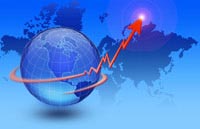US economic growth slows to 2.6% in Q4 2014
31 Jan 2015
Economic growth in the world's largest economy has cooled off to 2.6 per cent in the fourth quarter, despite increased consumer spending that was offset by weaknesses in other sectors, according to advanced gross domestic product (GDP) estimate released by the US commerce department yesterday.
 The slowdown in the December quarter followed a robust 5-per cent growth in the third quarter and a 4.6-per cent increase in the second quarter.
The slowdown in the December quarter followed a robust 5-per cent growth in the third quarter and a 4.6-per cent increase in the second quarter.
Overall, the US economy expanded 2.4 per cent in 2014 following a 2.2-per cent growth in 2013. On an average, the economy has grown 2.2 per cent during the past five years since the 2009 recession, on the back of massive stimulus measures by the government.
Economists believe that strong consumer spending would drive the GDP growth to over 3 per cent this year.
The increase in real GDP in the fourth quarter reflected positive contributions from personal consumption expenditures, private inventory investment, residential and non-residential fixed investment, exports, state and local government spending, that were partly offset by negative contributions from federal government spending as well as imports.
Consumer spending, which accounts for about 70 per cent of overall economic activity, grew 4.3 per cent in Q4, up from 3.2 per cent in the third quarter, registering its strongest gain in almost nine years and contributing 2.87 per cent to the GDP.
Non-residential fixed investment dropped to 1.9 per cent in Q4 from 8.9 per cent in the in Q3, while residential fixed investment increased 4.1 per cent compared with an increase of 3.2 per cent. Overall, fixed investment contributed 0.37 per cent to the GDP, while private inventories accounted for 0.82 per cent.
Global trade, net exports and imports of goods and services which contributed 0.8 per cent to the economic growth in the third quarter reduced it by a full percentage point in the fourth quarter.
Exports of goods and services fell to 2.8 per cent in Q4 from 4.5 per cent in the previous quarter adding 0.37 per cent to the GDP.
Imports shot up to 8.9 per cent during the quarter compared to a negative 0.9 per cent in Q3, resulting in a negative impact of 1.39 to the GDP in the last quarter.
Federal government spending that increased 9.9 per cent in Q3 on the back of high defence spending, posted a decrease of 7.5 per cent in Q4, making a negative contribution of 0.54 per cent to the GDP.
However, state and local government spending slightly improved to 1.3 per cent in Q4 from 1.1 per cent in Q4 and added 0.14 per cent to GDP.
A second GDP estimate for the fourth quarter based on more complete data will be released on 27 February 2014.
Despite the year-end slowdown, the US is one of the fastest growing economies in the developed world along with the UK, which has posted a 2.6-per cent GDP growth in 2014. (See: UK recovers with 2.6% GDP growth in 2014)
China, the world's second-largest economy is also slowing down, while Japan and Italy are in recession. German growth in 2015 has been trimmed to 1 per cent while France posted a mere 0.3-per cent growth in the third quarter.
According to some economists, the US growth in 2015 will be strongest in at least a decade. The IMF forecasts the US economy to grow at 3.6 per cent this year. Previously, the country's economy had expanded 3.8 per cent in 2004.
Analysts believe that the over 55 per cent slump oil prices in just seven months will result in huge savings for consumers that could boost spending.
Earlier this week, the US federal reserve said it would wait before raising short-term interest rates which are currently at near-zero levels. Although the officials are upbeat on the economic outlook, they expressed some caution about low inflation and the global environment.